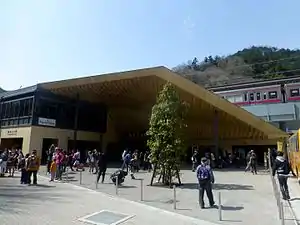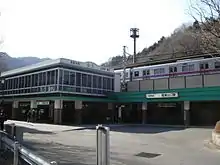Takaosanguchi Station
Takaosanguchi Station (高尾山口駅, Takaosanguchi-eki) is a railway station on the Keio Takao Line in Hachiōji, Tokyo, Japan, operated by the private railway operator Keio Corporation. It is the main point of railway access to Mount Takao.
Takaosanguchi Station 高尾山口駅 | |
|---|---|
 Takaosanguchi Station in March 2016 | |
| Location | 2241 Takao-machi, Hachiōji-shi, Tokyo 193-0844 Japan |
| Operated by | |
| Line(s) | |
| Distance | 44.7 km from Shinjuku |
| Platforms | 1 island |
| Tracks | 2 |
| Connections | Bus stop |
| Other information | |
| Station code | KO53 |
| Website | www |
| History | |
| Opened | 1 October 1967 |
| Rebuilt | 2015 |
| Passengers | |
| FY2015 | 11,110 daily |
| Location | |
 Takaosanguchi Station Location within Japan | |
Lines
Takaosanguchi Station is the terminus of the Keio Takao Line, and is located 8.6 kilometers from the starting point of the line at Kitano, and 44.7 kilometers from Shinjuku Station in central Tokyo. The station is numbered "KO53".
Station layout
Track layout | |||||||||||||||||||||||||||||||||||||||||||||||||||||||||||||||
|---|---|---|---|---|---|---|---|---|---|---|---|---|---|---|---|---|---|---|---|---|---|---|---|---|---|---|---|---|---|---|---|---|---|---|---|---|---|---|---|---|---|---|---|---|---|---|---|---|---|---|---|---|---|---|---|---|---|---|---|---|---|---|---|
| |||||||||||||||||||||||||||||||||||||||||||||||||||||||||||||||
The station has a single dead-headed island platform serving two tracks located on the second floor ("2F") level, with the station entrance and concourse located on the ground floor.
Platforms
| 1/2 | ■ Keio Takao Line | for Takao and Kitano |
 Platform 2 looking toward Kitano in February 2009
Platform 2 looking toward Kitano in February 2009 Platform 2 looking toward the buffer stops in March 2016
Platform 2 looking toward the buffer stops in March 2016 The buffer stops at the ends of the tracks in November 2014
The buffer stops at the ends of the tracks in November 2014 Keio Takaosan Onsen Gokurakuyu(Construction next to station)
Keio Takaosan Onsen Gokurakuyu(Construction next to station)
Adjacent stations
| « | Service | » | ||
|---|---|---|---|---|
| Keio Takao Line | ||||
| Takao | Special Express | Terminus | ||
| Takao | Semi Special Express | Terminus | ||
| Takao | Express | Terminus | ||
| Takao | Semi Express | Terminus | ||
| Takao | Rapid | Terminus | ||
| Takao | Local | Terminus | ||
History

The station opened on October 1, 1967.[1]
The station building was rebuilt in 2015 using wood from local cedar trees in a redesign overseen by architect Kengo Kuma, with work completed in April 2015. The station roof is modelled after the Yakuo-in Temple complex on Mount Takao.[2]
Passenger statistics
In fiscal 2015, the station was used by an average of 11,110 passengers daily.[2]
Surrounding area
- Mount Takao
- National Route 20
- Kiyotaki Station on the Takaotozan Railway

See also
References
- Terada, Hirokazu (19 January 2013). データブック日本の私鉄 [Databook: Japan's Private Railways] (in Japanese). Japan: Neko Publishing. p. 229. ISBN 978-4-7770-1336-4.
- "Railways incorporating more wood in train stations to give them rustic, natural feel". The Japan Times. Japan: The Japan Times Ltd. 24 August 2016. Archived from the original on 25 August 2016. Retrieved 25 August 2016.